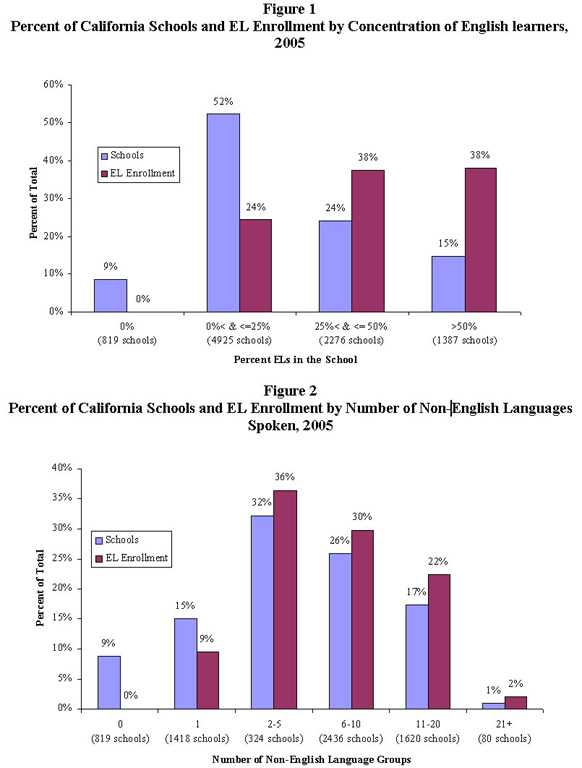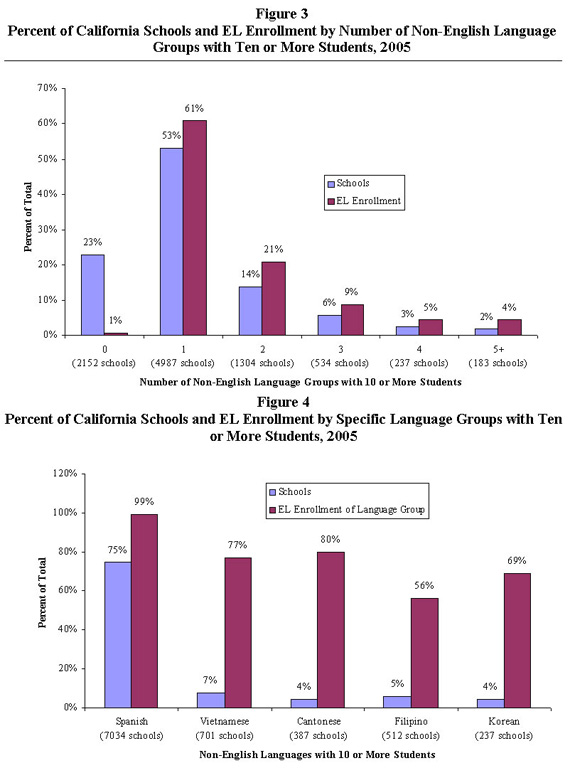Study Finds Widespread Segregation of California's English Learners


A new study finds that California's English learners--students who are not yet proficient in English--attend highly segregated schools, which hinders their educational opportunities. The study found that, at the elementary school level, more than half of California's English learners attended just 21 percent of the state's public schools, where they comprised more than 50 percent of the student body. The study also found that 80 schools in the state have English learners from more than 20 language backgrounds.
The study was conducted by researchers from the University of California Linguistic Minority Research Institute (UC LMRI), a systemwide center based at UC Santa Barbara. According to the researchers, segregation limits educational opportunities for English learners, or ELs, in several ways. First, many English learners in California are handicapped by their lack of access to native English speakers, who serve as language "role models." Second, most English learners in California come from low-income homes, so high concentrations of English learners also means many English learners attend low-income schools, a significant disadvantage. Third, schools with high concentrations of English learners are less likely to have fully certified teachers than schools with low concentrations of English learners, even after accounting for differences in school poverty.
The study has important implications for state policy at a time when California and other states with high concentrations of English learners are struggling to meet state and federal accountability goals, including those imposed by the federal No Child Left Behind Act.
"These findings show that some schools face much greater challenges in educating students and meeting state and federal mandates than other schools, and they should be given the support and resources to meet those mandates," said Russell W. Rumberger, director of the UC institute. Current funding formulas, he added, are simply based on the number of ELs in the school, not the language diversity or concentration.
In addition to Rumberger, who is also a professor at the Gevirtz Graduate School of Education at UC Santa Barbara, the researchers involved in the study were Patricia Gándara, associate director of the institute and a professor of education at UC Davis, and Barbara Merino, also a professor of education at UC Davis.
The study was based on data from the 2004-05 California Basic Education Data System (CBEDS) and the 2005 Language Census collected from all California public schools. It was published in the latest issue of the UC LMRI newsletter (Where California's English Learners Attend School and Why It Matters) and is available online at: http://lmri.ucsb.edu/publications/newsletters/v15n2.pdf.
The study found widespread language diversity in California's public schools. Although 85 percent of California's English learners speak one language--Spanish--most schools in the state serve a number of language groups. More than 4,000 schools in California--almost half of the schools in the state--have English learners from at least six language backgrounds, and 80 schools have EL students from more than 20 language backgrounds. Although most schools have a concentration of English learners from only one or two language groups, 183 schools in California have 10 or more students in five or more language groups.
Serving a large number of languages, the scholars said, presents a different challenge for schools. For instance, locating and organizing staff and volunteers who can communicate with all the various language communities may be difficult. And grouping students for instruction by teachers able to communicate with them in their own language is organizationally much more challenging. Schools where the vast majority of English learners come from one or two language groups, in contrast, have more educational options for meeting the needs of their students. Such schools can more easily offer primary language instruction if the parents request it. Even if schools only provide English immersion programs, schools with a concentration of only one or two non-English language groups may be able to provide bilingually certified teachers who can communicate with all of the children, can more readily assess the educational needs of all of their students, and can more easily communicate with students' parents.
The authors make several recommendations for addressing the problem of segregation and language concentration in California schools. First, the state should develop more options for English learners to reduce their segregation, and provide improved working conditions and additional incentives for qualified teachers to teach in schools with high concentrations of English learners. Second, the allocation of resources to schools should be based on more than simply the number of English learners, but should consider the concentration and language backgrounds of the English learners in the schools, since these factors also influence the opportunities and constraints that exist in meeting the needs of English learners. Third, the state should support the training of more bilingually certified teachers. Not only are bilingually certified teachers able to provide primary language instruction and support in schools that continue to offer such programs, these teachers are the most skilled at working with English learners and their families, irrespective of the type of instructional program they are in.
Four charts based on 2005 data accompany this news release (or view them at http://www.ia.ucsb.edu/pa/display.aspx?pkey=1438) :
·Percent of California Schools and English learner (EL) enrollment by Concentration of English learners
·Percent of California schools and EL enrollment by number of non-English Languages spoken
·Percent of California schools and EL enrollment by number of non-English language groups with 10 or more students
·Percent of California schools and EL enrollment by specific language groups with 10 or more students
ABOUT UC LMRI
The University of California Linguistic Minority Research Institute (UC LMRI) was established in 1984 in response to the California Legislature's request that the University of California's Office of the President (UCOP) pursue "…knowledge applicable to educational policy and practice in the area of language minority students' academic achievement and knowledge," including their access to the University of California and other institutions of higher education. The systemwide headquarters has been located at UC Santa Barbara since 1987 and an Education Policy Center was established at UC Davis in 1997 to disseminate research findings to policy makers. To carry out its mission, the UC LMRI funds research by UC faculty members and graduate students; provides professional development for researchers, educators, and policymakers; and disseminates information on educational issues affecting linguistic minorities, as well as racial and ethnic minorities, and immigrants. More information is available on the institute's Web site: http://lmri.ucsb.edu/.
Related Links



